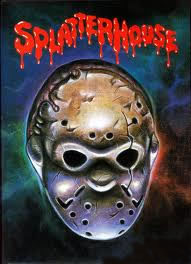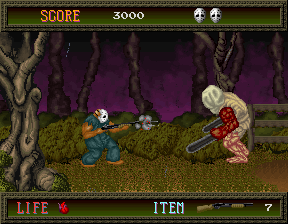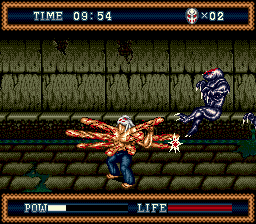Long before there was Resident Evil and years before Joe Lieberman went on his crusade against Night Trap and Mortal Kombat, there was Splatterhouse. As one of the first gory games made widely available on consoles (and the first to feature a parental advisory disclaimer), it fused all the elements gamers loved about horror films with the familiar terrain of action gaming. Spooky, gory yet always fun, Splatterhouse quickly became a fan favorite and remained popular until it mysteriously disappeared from the gaming scene after the third installment was released on the Sega Genesis.
Developer History
 The creative minds behind the Splatterhouse series hail from the Japanese software powerhouse Namco. Though the team behind the games hasn’t received prestige on the level of other groups like Sonic Team or RED, their work produced a blockbuster franchise that is practically synonymous with the company’s name. Led by Hiroshi Yokoyama, the small group of about a dozen people may still be at Namco, but it is unclear what happened to them after they finished the third installment. No official credit has ever been heaped upon them, as the gaming industry tends to do with those who create blockbusters, and it is both unfortunate and odd that the creators of Splatterhouse have never received the recognition they deserve.
The creative minds behind the Splatterhouse series hail from the Japanese software powerhouse Namco. Though the team behind the games hasn’t received prestige on the level of other groups like Sonic Team or RED, their work produced a blockbuster franchise that is practically synonymous with the company’s name. Led by Hiroshi Yokoyama, the small group of about a dozen people may still be at Namco, but it is unclear what happened to them after they finished the third installment. No official credit has ever been heaped upon them, as the gaming industry tends to do with those who create blockbusters, and it is both unfortunate and odd that the creators of Splatterhouse have never received the recognition they deserve.
Namco, on the other hand, grew quite extensively once it was freed from Nintendo’s iron-clad licensing contract, and it released several titles for the Genesis and Turbo Grafx-16 during the 16-bt era, including Burning Force and two Rolling Thunder sequels. Since then, Namco has become one of the premier third party publishers on all consoles, especially the Playstation 2.
The Games
You don’t have to guess too hard to figure out from where Yokoyama and his group drew their inspiration for Splatterhouse. The game is a literal monument to 80s horror flicks. The main characters, Rick and his girlfriend Jennifer, are parapsychology majors writing a term paper on the mysterious Dr. West, who disappeared years ago while working on horrible experiments with the dead. The pair make their way to his secluded mansion to investigate for clues and are trapped by a rainstorm. Immediately enveloped by darkness and sealed in the mansion, Jennifer disappears and Rick is knocked unconscious. When he awakens, his face is covered by the Terror Mask – the ancient, Aztec sacrificial artfact that Dr. West had been studying before his disappearance. As the power of the mask courses through his body, Rick sets out through the mansion to rescue Jennifer and discover the source of the evil and West’s whereabouts. This marks the first of many times that poor Rick has had to schlep off and save his kidnap-prone girlfriend. It seems to be the unavoidable lot in life for platforming and action heroes.
If that isn’t vintage horror, I don’t know what is. Fans of the genre will recognize the nefarious Dr. West’s mansion as the same one from Lovecraft’s classic Reanimator. The parallels with other movies and books are numerous, to say the least. Beside the obvious references to Friday the 13th, there are also elements from the Evil Dead series, as well as several other obscure films. Whether they are deliberate or pure coincidence is unknown, but no one can deny the similarities.
Such adhesion to the staples of modern horror cinema no doubt played a large part in the game’s success when it was released in 1988. Combined with some very solid gameplay, it created a winning formula that was markedly different that what was commonly seen in arcades of the time. So different was it, that Splatterhouse became the first game to ever feature a parental warning label – a full four years before Mortal Kombat. The graphic violence and gore was enough to get it banned in most U.S. arcades, as many people (especially those in the government) didn’t warm up to images like the level four boss – called “Evil Cross” in the PC-Engine manual – which was composed of severed heads orbiting an upside down cross. Splatterhouse stood out like a sore thumb among the myriad of kid-friendly coin-ops that filled American arcades, and as news of the Satanic imagery spread, it slowly began to disappear. Eventually, it all but vanished from most big-name locales and was relegated to pizza shops and other out-of-the-way hide outs, far from where most gamers could find it.
 Luckily, Namco released a home version in 1990 for the Turbo Grafx-16. Although edited for content (the aforementioned boss and several other controversial images were removed from the U.S. version but remained in the Japanese release) and lacking the same level of graphical detail, it’s still an excellent port. A more faithful version appeared on the FM Towns Marty in Japan two years later with all its content intact, and it is considered the definitive home version, but is very rare and not very accessible to those of us across the pond.
Luckily, Namco released a home version in 1990 for the Turbo Grafx-16. Although edited for content (the aforementioned boss and several other controversial images were removed from the U.S. version but remained in the Japanese release) and lacking the same level of graphical detail, it’s still an excellent port. A more faithful version appeared on the FM Towns Marty in Japan two years later with all its content intact, and it is considered the definitive home version, but is very rare and not very accessible to those of us across the pond.
Many gamers believed Splatterhouse to be NEC’s killer app for the Turbo in view of the Genesis’s American debut, and it was widely believed that the series would remain as an exclusive, giving NEC a powerful weapon with which to take on the competition. Surely such a big arcade and console hit would lead to a sequel, and offer gamers a reason to stick with the slowly sinking Turbo Grafx-16. Such big name titles were few and far between on the console, and Splatterhouse would have been quite a feather in NEC’s cap.
We all know this didn’t happen.
Splatterhouse 2 appeared on the Genesis the same year as the original was making the rounds on the FM Towns Marty, to the delight of Segaphiles everywhere. It picked up the story three months after the original, with Rick still agonizing over Jennifer’s disappearance. He is haunted by nightmares of of the mask tormenting him, goading him into returning to the mansion. Can he still save her? Should he risk donning the mask again? Its evil influence slowly consumes the wearer, and Rick was beginning to enjoy its power. Perhaps he could save Jennifer by using it one last time, and he would take it off as soon as the job was done. The decision made, it was back to the house of evil for Rick.
As with most sequels, Splatterhouse 2 was essentially more of what made the first game so much fun. The gameplay remained intact, with all the great weapons and explosive anatomy making a return in grand style. The more powerful hardware was put to great use by Namco, and the graphics received a welcome facelift. The box cover was strangely missing any disclaimer or warning, an odd change considering how much more bloody the game is. For example, upon dispatching the level three boss, its entire body explodes and covers the screen in blood that slowly drips down. It may look cheesy by today’s standards, but at the time it was an awesome sight to see in an American game. There were also some great visual effects used, like the waves of agonizing faces in stage two. The eight megs of memory were a significant upgrade, and allowed for better graphical detail and stage variety. It is my favorite in the series, and while I seem to be in the minority in that regard, there’s just something about the classic Splatterhouse gameplay that part two does so right.
It has often been rumored that Splatterhouse 2 saw an arcade release before coming home to the Genesis. All evidence, however, points to the contrary. The Namco official history (available in any volume of Namco Museum on the Playstation) lists every game done by the company since 1978, and there is no mention in any of a sequel to Splatterhouse. Moreover, the Killer List of Video Games, System-16’s Namco hardware page, nor the Arcade History Database have any listing for it. It’s highly unlikely that Namco would release it in such few quantities so as to make its existence questionable, and it is more plausible to think that they instead designed Splatterhouse 2 as a console exclusive.
Regardless, as the series progressed, so did the controversy. When Splatterhouse 3 was released in 1993, it quickly found itself a target of the Lieberman senate witch hunt., alongside such youth-corroding examples of evil like Night Trap and Mortal Kombat. When Senate hearings began investigating the dangers of violence in video games back in 1993, an ad for it was brought up by those arguing in favor of a ratings system. In direct defiance to the senate’s efforts to curve the influence of video games among children, the ad brazenly read Splatterhouse 3 for the Sega Genesis is the kind of game rating systems were invented for. As usual with the government, it took the release of a full three Splatterhouse games before they finally noticed something questionable and decided to investigate. Makes you proud to be a taxpayer, doesn’t it?
Not to say that there wasn’t anything worth questioning, because there certainly was. Splatterhouse 3 further developed the storyline of Rick and his battle to save his loved ones from the evils of the mansion, in addition to his own temptation to give in to the power of the mask. Bigger and more challenging than the previous two entries, the second sequel made some radical changes to the gameplay, which still draws a dividing line among fans of the series. No longer a mere side-scrolling action game, part three was now a full-fledged beat-’em-up along the lines of Streets of Rage and Final Fight. Rick’s mask now covered most of his head, and imbued him with more awesome power than ever before. In addition to his patented punch and kick, he was now able to dish out some mean special moves by hulking up after grabbing scattered Eldritch orbs. Looking more like a pumped up Predator than a human adolescent, Rick’s attacks were brutally efficient while the power lasted, the most devastating one depicting several arms shooting out of his body, annihilating everything onscreen.
 Among the more notable changes made to the formula was the addition of timed gameplay. You were on the clock now, as Jennifer had been infected with a boreworm that was slowly eating away at her from within. Even worse off was your son David, who somehow decided that the mansion would be a good place to play and disappeared somewhere inside, a ton of monsters in tow. If you couldn’t get to either of them before it was too late, and they were toast. To reach them as quickly as possible, you had to navigate through each successive floor of the mansion, choosing your route as soon as each room was cleared. Much harder than the earlier titles, Splatterhouse 3‘s gameplay could be brutally hard at times. Rick had an annoying tendency to fall over with the slightest touch, and getting knocked down even once while holding a weapon meant it would be taken away by a spirit. You had the option to go retrieve it, but this meant sacrificing vital time. Still, many consider this to be the best of the bunch, and feel that this is the direction any future entries should follow.
Among the more notable changes made to the formula was the addition of timed gameplay. You were on the clock now, as Jennifer had been infected with a boreworm that was slowly eating away at her from within. Even worse off was your son David, who somehow decided that the mansion would be a good place to play and disappeared somewhere inside, a ton of monsters in tow. If you couldn’t get to either of them before it was too late, and they were toast. To reach them as quickly as possible, you had to navigate through each successive floor of the mansion, choosing your route as soon as each room was cleared. Much harder than the earlier titles, Splatterhouse 3‘s gameplay could be brutally hard at times. Rick had an annoying tendency to fall over with the slightest touch, and getting knocked down even once while holding a weapon meant it would be taken away by a spirit. You had the option to go retrieve it, but this meant sacrificing vital time. Still, many consider this to be the best of the bunch, and feel that this is the direction any future entries should follow.
You would think that the story ends there, but there is yet another game to discuss. Released only in Japan for the Famicom system, Splatterhouse: Wanpaku (Naughty) Graffiti is more of a parody than an official sequel. The super deformed graphics are still quite gory, and feature the entire cast as children! Rick has been revived (why is he even dead?), mask and all, to once again save Jennifer, this time from the Pumpkin King. As an original title, Wanpaku Graffiti stands pretty well on its own. It should be played with tongue firmly in cheek, and fans of the series would do well to check it out. An English patched version can be had over at The Whirlpool.
Has the Mask Finally Won?
Namco recently released a game in Japan called The Splatter Action, which got gamers unnecessarily excited. Aside from the allusion in the title, there is no relation to the classic Splatterhouse we all know and love. Also, a Splatterhouse table was done for Video Pinball. Not the addition gamers were hoping for, but it was nice to see the brand get some recognition.
In truth, the last official release of a game in the series was Splatterhouse 3 back in 1993. No other sequels have been announced, and Namco hasn’t even bothered to add any of the three titles to their numerous Museum rehashes. Some dedicated fans started an online petition for a compilation a few years ago, but we all know how well those work. For the foreseeable future, we will simply have to enjoy the trilogy we have and pray Namco can tear itself away from Tekken and Ridge Racer long enough to revisit this cherished part of its history.
The complete release chronology is as follows:
- Splatterhouse, Arcade (1988)
- Splatterhouse, LCD Handheld (1988)
- Splatterhouse: Wanpaku Graffiti, Famicom (1989)
- Splatterhouse, Turbo Grafx-16 (1990)
- Splatterhouse, FM Towns (1992)
- Splatterhouse 2, Genesis (1992)
- Splatterhouse 3, Genesis (1993)
Sources
- Blaine. Splatterhouse: Wanpaku Graffiti review. Prizm Dash. August 27, 2002.
- Game Info. West Mansion.
- Splatterhouse Arcade Info. Coin-Op Museum.

Recent Comments